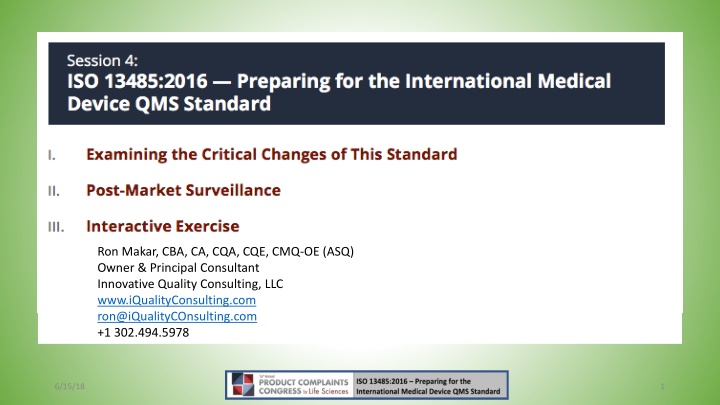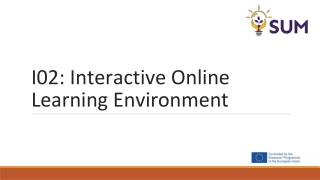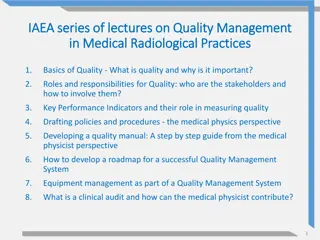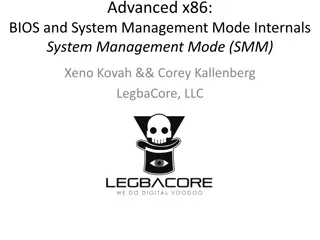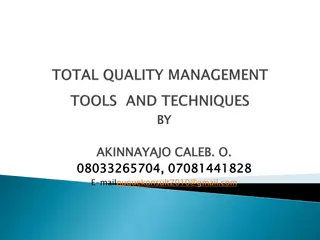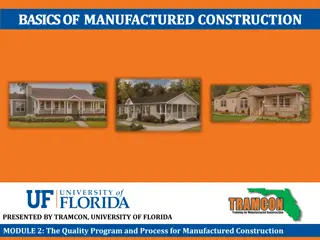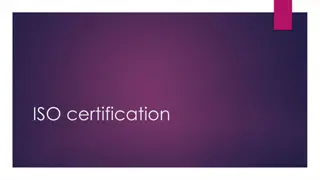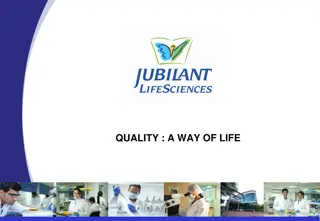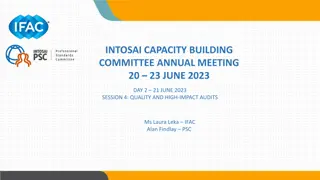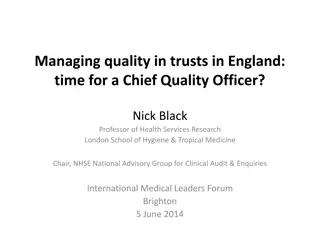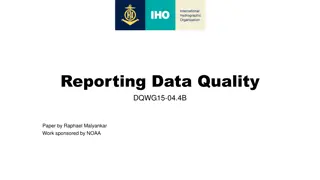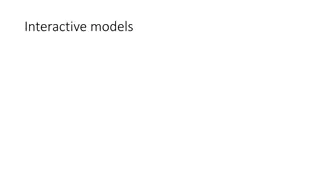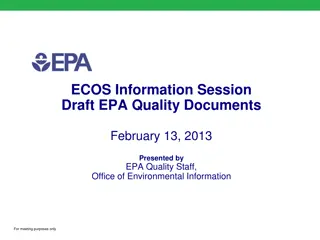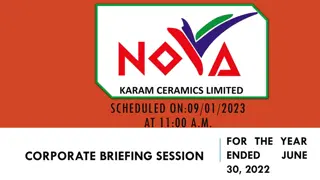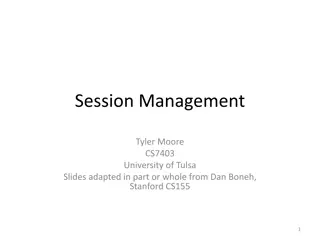Quality Management System Interactive Session Overview
Explore key concepts of quality management systems through interactive exercises and discussions. Gain insights into industry standards and regulations, with a focus on improving organizational processes and mitigating risks. Learn from real-world experiences and enhance your understanding of quality management practices.
Download Presentation

Please find below an Image/Link to download the presentation.
The content on the website is provided AS IS for your information and personal use only. It may not be sold, licensed, or shared on other websites without obtaining consent from the author.If you encounter any issues during the download, it is possible that the publisher has removed the file from their server.
You are allowed to download the files provided on this website for personal or commercial use, subject to the condition that they are used lawfully. All files are the property of their respective owners.
The content on the website is provided AS IS for your information and personal use only. It may not be sold, licensed, or shared on other websites without obtaining consent from the author.
E N D
Presentation Transcript
Ron Makar, CBA, CA, CQA, CQE, CMQ-OE (ASQ) Owner & Principal Consultant Innovative Quality Consulting, LLC www.iQualityConsulting.com ron@iQualityCOnsulting.com +1 302.494.5978 6/15/18 1
Thank You for Attending! Thank You for Attending! . we know you have choices . we know you have choices This is a really a 3 part session: 50 mins: Examining the Critical Changes of this Standard Post Market Surveillance 10 min. Q&A transition/break 20 mins: Interactive Exercise 10 mins: Final Q&A Name one thing you are taking away from this session Bonus Material: Audit checklist: FDA QSR, ISO 13485:2016, ISO 9001:2015 2 6/15/18
Interactive Exercise: Begin to Think about it now! Interactive Exercise: Begin to Think about it now! Consider the front end of those elements that structure your business and quality management systems: ISO 9001:2015 Clause 4.1: Understand the Organization and Its Context Clause 4.2: Understanding the Needs and Expectations of Interested Parties 6/15/18 3
Interactive Exercise: Begin to Think About it Now! Interactive Exercise: Begin to Think About it Now! Using the PDCA model of a QMS, with consideration to interested parties, internal and external factors, identify potential hazardous (unwanted) situations (failure modes) that could occur, and what you might do to mitigate/control/reduce/eliminate that risk. Reference: ISO 9001, 5th edition, 2015-09-15, clause 0.3.2 Plan-Do- Check-Act cycle] 6/15/18 4
Objectives of this Session Objectives of this Session To think a bit differently about your business and quality management systems. Learn from each other Q&A 5 6/15/18
Session Format Session Format Present Info. from the Standard, other Sources Share Observations (where relevant) Ask Questions Copy of the slides will be emailed to you upon request 6 6/15/18
Session Materials Session Materials 1. References from the Web (provided) 2. Personal Observations from: 1. Personal experiences having established medical device quality systems 2. Observations made from auditing other medical device organizations Disclaimer: References to sites or products is not necessarily an endorsement of them. 7 6/15/18
Just Checking Just Checking Who, among you 1. Has their QMS certified to ISO 9001:2016? 2. Is upgrading from 2003 or 2012 version? 3. Is certifying for the first time? 4. Is a finished medical device manufacturer? 5. Is a supplier to a finished medical device manufacturer? 6. Has their QMS certified to ISO 9001:2015? 7. Industry: 1. Medical Devices Only? 2. Pharma. Only? 3. Combination Products? 4. Biologics? 8 6/15/18
Keep in Mind: Complaints (def.) Keep in Mind: Complaints (def.) 21 CFR Part 820.3(b) Any written, electronic or oral communication that alleges deficiencies related to the identity, quality, durability, reliability, safety, effectiveness or performance of a device after it is released for distribution. 9 6/15/18
Keep in Mind: Post Mkt. Surveillance (def.) Keep in Mind: Post Mkt. Surveillance (def.) 21 CFR Part 822.3(i) The active, systematic, scientifically valid collection, analysis, and interpretation of data or other information about a marketed device. 10 6/15/18
Just Checking Just Checking Who, among you 1. Has their QMS certified to ISO 9001:2016? 2. Is upgrading from 2003 or 2012 version? 3. Is certifying for the first time? 4. Is a finished medical device manufacturer? 5. Is a supplier to a finished medical device manufacturer? 6. Has their QMS certified to ISO 9001:2015? 7. Industry: 1. Medical Devices Only? 2. Pharma. Only? 3. Combination Products? 4. Biologics? 11 6/15/18
Examining Critical Changes of the Standard Examining Critical Changes of the Standard We will look at: Critical Changes Documents Required Integrating with FDA QSR differences & similarities How Risk-based Approach (RBA) applies Integrating your business processes into the standard 6/15/18 12
Critical Changes (Summary) Critical Changes (Summary) Aligns with U.S. QSR and multinational Medical Device Single Audit Program (MDSAP) The Standard is brought into alignment with the nonconformance grading systems of the MDSAP program Addition of provisions emphasizing the importance of measuring and managing risk and harmonizing with other standards The ideas and concepts in the Standard are somewhat generic, which are made specific by the regulations in a given region 6/15/18 13
Critical Changes: ISO 13485:2016 Vs. 2003 Critical Changes: ISO 13485:2016 Vs. 2003 Reference: www.praxiom.com (1 of 6) Area of Interest Changes/Differences General Essentially same topics covered 2003 version based on ISO 9001:2000; 2016 based on ISO 90011:2008 Flexibility More flexible: Can exclude any requirements in clauses 6, 7 or 8 if justifiable Regulatory Requirements Must comply with all applicable regulatory requirements (statutory, legal) The organization is expected to set objectives for regulatory requirements in addition to setting objectives for meeting product requirements Risk-based Approach Expected to apply Risk-based Approach (Risk-based Thinking) to all QMS processes Medical Device File Expected to include a description of each medical device or family of devices, and include all associated specs., procedures & records 6/15/18 14
Critical Changes: ISO 13485:2016 Vs. 2003 Critical Changes: ISO 13485:2016 Vs. 2003 Reference: www.praxiom.com (2 of 6) Area of Interest Changes/Differences Record Keeping Expected to record supplier monitoring and re-evaluation activities and consider privacy regulations Product Realization Additional requirements: Establish product handling, storage, measuring, revalidation and traceability User Training Expected to think about safety and performance of products and the associated training needs of users and to verify that regulatory requirements will be met and user training will be available before supplying products to customers Design and Development Inputs Expected to consider risk management outputs, to clarify product usability and safety requirements, and to ensure that input requirements can be verified and validated 6/15/18 15
Critical Changes: ISO 13485:2016 Vs. 2003 Critical Changes: ISO 13485:2016 Vs. 2003 Reference: www.praxiom.com (3 of 6) Area of Interest Changes/Differences Design and Development Verification & Validation Document V & V plans and arrangements Expected to think about how to verify and validate medical devices that connect to or interface with other medical devices, and verify design outputs when these devices are connected, and validate the intended use requirements when these devices are connected Design & Development Changes Establish processes to control changes and evaluate their significance and impact, and maintain a file for each medical device or family of medical devices that documents these changes Design & Development Transfer Emphasis to ensure that outputs are suitable for manufacturing before becoming product specs. 6/15/18 16
Critical Changes: ISO 13485:2016 Vs. 2003 Critical Changes: ISO 13485:2016 Vs. 2003 Reference: www.praxiom.com (4 of 6) Area of Interest Changes/Differences Purchasing Need to consider the risk to the medical device in addition to the effect purchased product has on the safety and performance of the medical device Need to make sure that suppliers are capable of meeting all relevant statutory requirementsin addition to organization s requirements Supplier Monitoring Need to consider risk to the medical device whenever suppliers underperform, and need to respond in a way that is proportional to the risk to the medical device Need to record supplier monitoring and re-evaluation activities Purchased Product Risks Need to consider the risk associated with the product purchased and consider what action to take when unanticipated changes are made to purchased products and to determine whether these changes affect the medical device or product realization process 6/15/18 17
Critical Changes: ISO 13485:2016 Vs. 2003 Critical Changes: ISO 13485:2016 Vs. 2003 Reference: www.praxiom.com (5 of 6) Area of Interest Changes/Differences Process Validation In addition to establishing procedures to validate production and service delivery processes that generate outputs that can t be verified until the product is in use or the service has been delivered, you are expected to establish validation plans and to revalidate processes whenever necessary Servicing In addition to having to document your organization's servicing procedures and reference materials, you're now also expected to analyze servicing records in order to identify servicing complaints and improvement opportunities 6/15/18 18
Critical Changes: ISO 13485:2016 Vs. 2003 Critical Changes: ISO 13485:2016 Vs. 2003 Reference: www.praxiom.com (6 of 6) Area of Interest Changes/Differences Complaints Expected that the organization develop procedures that comply with all applicable requirements. Specifies minimum requirements Delivery of Non- conforming Product The organization is expected to investigate nonconforming products that have been delivered, to determine if corrective action is needed, and to consider whether or not responsible external parties need to be identified. Improvement Expected to maintain safety and performance of products whenever improvements are being considered. Before CAPA implemented, expected to verify that they comply with applicable regulatory requirements and that they do not compromise the safety and performance of the medical device. 6/15/18 19
Documents Required Documents Required (slide 1 of 8) (slide 1 of 8) The organization shall document: Clause No. Requirement 4.1.1 Roles undertaken by the organization under applicable regulatory requirements (clause 4.1.1) 4.1.6 Procedure and records for the validation of the application of computer software (clause 4.1.6) 4.2.2 Quality Manual (clause 4.2.2) 4.2.3 Medical device file (clause 4.2.3) 4.2.4 Procedure for document control (clause 4.2.4) 4.2.5 Procedure for record control (clause 4.2.5) 5.3 Quality policy (clause 5.3) 5.4.1 Quality objectives (clause 5.4.1) 6/15/18 20
Documents Required Documents Required (slide 2 of 8) (slide 2 of 8) The organization shall document: Clause No. Requirement 5.5.1 Responsibilities and authorities (clause 5.5.1) 5.6.1 Procedure and records for management review (clause 5.6.1) 6.2 Procedure for training (clause 6.2) 6.3 Requirements for infrastructure and maintenance activities (clause 6.3) 6.4.1 Requirements for work environment (clause 6.4.1) 6.4.2 Arrangements for control of contaminated or potentially contaminated product (clause 6.4.2) 7.1 Process for risk management in product realization (clause 7.1) 7.1 Outputs of product realization planning (clause 7.1) 6/15/18 21
Documents Required Documents Required (slide 3 of 8) (slide 3 of 8) The organization shall document: Clause No. Requirement Records of the results of the customer requirements review and actions arising from it (clause 7.2.2) Arrangements for communication with customers (clause 7.2.3) 7.2.2 7.2.3 7.3.1 Procedure for design and development (clause 7.3.1) 7.3.2 Design and development planning (clause 7.3.2) 7.3.4 Design and development outputs (clause 7.3.4) 7.3.5 Records of design and development review (clause 7.3.5) 7.3.6 Design verification plans, results and conclusions (clause 7.3.6) 7.3.6 Design validation plans, results and conclusions (clause 7.3.6) 6/15/18 22
Documents Required Documents Required (slide 4 of 8) (slide 4 of 8) The organization shall document: Clause No. Requirement 7.3.8 Procedure for transfer of design and development outputs to manufacturing (clause 7.3.8) 7.3.9 Procedure and records for control of design and development changes (clause 7.3.9) 7.3.10 Design and development file (clause 7.3.10) 7.4.1 Procedure for purchasing (clause 7.4.1) 7.4.1 Criteria and records for evaluation and selection of suppliers (clause 7.4.1) 7.4.3 Record of verification of purchased product (clause 7.4.3) 7.5.1 Record for each medical device or batch that provides traceability (clause 7.5.1) 7.5.2 Requirements for cleanliness of product (clause 7.5.2) 6/15/18 23
Documents Required Documents Required (slide 5 of 8) (slide 5 of 8) The organization shall document: Clause No. Requirement Requirements for medical device installation and acceptance criteria for verification of installation (clause 7.5.3) Records for medical device installation and verification of installation (clause 7.5.3) 7.5.3 7.5.3 7.5.4 Procedure and records for servicing of the medical device (clause 7.5.4) 7.5.5 Records of sterilization process (clause 7.5.5) 7.5.6 Procedure and records of production and service provision process validation (clause 7.5.6) Procedure and records for validation of process for sterilization and sterile barriers systems (clause 7.5.7) Procedure for product identification (clause 7.5.8) 7.5.7 7.5.8 7.5.9.1 Procedure for traceability (clause 7.5.9.1) 6/15/18 24
Documents Required Documents Required (slide 6 of 8) (slide 6 of 8) The organization shall document: Clause No. Requirement 7.5.9.2 Records of traceability and name and address of the shipping package consignee (clause 7.5.9.2) 7.5.10 Report on changes on customer property (clause 7.5.10) 7.5.11 Procedure for preserving the conformity of product (clause 7.5.11) 7.6 Procedure for monitoring and measuring (clause 7.6) 7.6 Record of calibration (clause 7.6) Procedure and records for validation of the application of computer software used for monitoring and measuring (clause 7.6) Procedure for customer feedback (clause 8.2.1) 7.6 8.2.1 8.2.2 Procedure and records for complaint handling (clause 8.2.2) 6/15/18 25
Documents Required Documents Required (slide 7 of 8) (slide 7 of 8) The organization shall document: Clause No. Requirement 8.2.3 Records of reporting to regulatory authorities (clause 8.2.3) 8.2.4 Procedure for internal audit (clause 8.2.4) 8.2.4 Records of audits and their results (clause 8.2.4) 8.2.6 Identity of the person authorizing release of product (clause 8.2.6) 8.3.1 Procedure and record of control of nonconforming product (clause 8.3.1) 8.3.3 Procedure for issuing advisory notices (clause 8.3.3) 8.3.4 Records of rework (clause 8.3.4) 8.4 Procedure and records for data analysis (clause 8.4) 6/15/18 26
Documents Required Documents Required (slide 8 of 8) (slide 8 of 8) The organization shall document: Clause No. Requirement 8.5.2 Procedure and records for corrective action (clause 8.5.2) 8.5.3 Procedure and records for preventive action (clause 8.5.3) 6/15/18 27
Integration with FDA QSR . Integration with FDA QSR . . A Few Key Points . A Few Key Points The 2013 version is in much better alignment with the U.S. QSR Vs. the 2003 version. Any medical device marketed in the U.S. must be in line with the QSR, regardless of where its bee designed and manufactured. ISO 13485:2016 is not legally sufficient to meet the U.S. requirements. Refer to an audit checklist comparing QSR to 13485 and build your system around this checklist Please see Bonus Materials slide at the end of this slide deck) 6/15/18 28
How Risk How Risk- -based Approach (RBA) Applies based Approach (RBA) Applies RBA Defined: The standards does not define RBA specifically! The essence of RBA is to consider the determination of safety and performance effects on product as well as determining any effects on regulatory requirements Vs. Risk Management: ISO 13485:2016, Clause 3.18, risk management systematic application of management policies, procedures and practices to the tasks of analyzing, evaluating, controlling and monitoring risk [SOURCE: ISO 14971:2007, 2.22] 13485:2016 does not specifically require device makers to follow ISO 14971 but clause 7.1 directs device makers to 14971. 6/15/18 29
How Risk How Risk- -based Approach (RBA) Applies based Approach (RBA) Applies Risk Reduction Process in ISO 14971:2007 and ISO 13485:2016 Risk Reduction Process in ISO 14971:2007 and ISO 13485:2016 Identify Hazards and Hazardous Situations ISO 14971;2007 ISO 13485:2016 Assess, Evaluate Risk Control Risk Design Output Design Input Measure and Control Residual Risk Source: Ombu Enterprises, LLC Design Verification 6/15/18 30
How Risk How Risk- -based Approach (RBA) Applies based Approach (RBA) Applies Risk Information Input in ISO 14971:2007 and ISO 13485:2016 Risk Information Input in ISO 14971:2007 and ISO 13485:2016 Gather Production Data Gather Post Production Data ISO 14971;2007 ISO 13485:2016 Monitor Information Safety Evaluation Update Risk Management Process Review Residual Risk Source: Ombu Enterprises, LLC 6/15/18 31
How Risk How Risk- -based Approach (RBA) Applies based Approach (RBA) Applies The following processes include the phrase proportionate to risk in 13485:2016 Controls over outsourced processes (4.1.5); QMS software validation and revalidation (4.1.6); Evaluating the effectiveness of actions related to competency (6.2); Establishing criteria for the evaluation and selection of suppliers (7.4.1); Addressing a supplier s non-fulfillment of purchasing requirements (7.4.1); Verification of purchased products (7.4.3); Validation and revalidation of production software (7.5.6); and Validation and revalidation of monitoring and measuring software (7.5.6). 6/15/18 32
How Risk How Risk- -based Approach (RBA) Applies based Approach (RBA) Applies Other areas in the Standard where risk is described: 4.1.2 b: apply a risk based approach to the control of the appropriate processes needed for the quality management system; 7.1 Planning of Product Realization The organization shall document one or more processes for risk management in product realization. Records of risk management activities shall be maintained (see 4.2.5 ). 7.3.3 Design and development outputs: Inputs relating to product requirements shall be determined and records maintained (see 4.2.5 ). These inputs shall include: c) applicable output(s) of risk management; 6/15/18 33
How Risk How Risk- -based Approach (RBA) Applies based Approach (RBA) Applies Other areas in the Standard where risk is described: 7.3.9 Control of design and development changes The review of design and development changes shall include evaluation of the effect of the changes on constituent parts and product in process or already delivered, inputs or outputs of risk management and product realization processes. 7.6 Control of monitoring and measuring equipment The specific approach and activities associated with software validation and revalidation shall be proportionate to the risk associated with the use of the software, including the effect on the ability of the product to conform to specifications. 8.2.1. Feedback The information gathered in the feedback process shall serve as potential input into risk management for monitoring and maintaining the product requirements as well as the product realization or improvement processes. 6/15/18 34
Integration of Business Processes Integration of Business Processes . What Other Risks Do You Need to Consider? . What Other Risks Do You Need to Consider? The Old Way: Make your business comply with the standard The New Way: Understand your business and apply the standard in a way that allows you to run your business, which includes meeting the requirements of all applicable regulatory requirements 6/15/18 35
Integration of Business Processes Integration of Business Processes . . What Other Risks Do You Need to Consider? What Other Risks Do You Need to Consider? ISO 9001:2015 Clause 4.1: Understand the Organization and Its Context Clause 4.2: Understanding the Needs and Expectations of Interested Parties 6/15/18 36
Integration of Your Business Processes Integration of Your Business Processes Begin with Contextual Analysis, Identification of Interested Parties and their Requirements Clause 4.2 Identify Interested Parties and their Requirements Reference: ISO 9001:2015 Step 2 Clause 6.1.2 Integrate Critical Sources of Risk Into the Processes Identified in 4.4 of the Standard for Your System Cause 6.1.1 Step 3 Identify Critical Sources of Risk Based on Issues and the Need to Meet Requirements Assess the Risk of Those Items Identified in Step 1 against the Interested Parties Requirements Clause 4.1 Step 1 Identify Internal and External Issues Source: Risk-Based Thinking Memory Jogger 6/15/18 37
Post Market Surveillance (PMS) Post Market Surveillance (PMS) We will look at: What the standard requires Complaint handling efficacy Reporting to regulatory authorities Capability of your infrastructure 6/15/18 38
PMS: What Does the Standard Require? PMS: What Does the Standard Require? Defined: A system that provides continuous feedback about a device on the market in order to maintain a high standard of product quality. PMS is a regulatory requirement in major markets like Europe and United States. Question: How well are you monitoring, measuring and trending production and post-production activities? 6/15/18 39
PMS: What the Standard Requires PMS: What the Standard Requires It s all about effective feedback and how this data connects with existing systems 1. Handling of Complaints 2. Recall & Advisory Notices 3. Audits: Internal & External 4. Corrective & Preventive Action 5. Non-conforming Product (Detected Before & After Delivery) 6. Customer Returns 7. Field Service Data/Reports 6/15/18 40
PMS: Efficacy PMS: Efficacy Questions: 1. Do you consider impact on existing hazardous situation and potential failure modes for all of the key Post Market Surveillance processes? 2. Do you consider the introduction of a possible new hazardous situation and/or failure mode for each Key element? 3. Do you document that these reviews were performed? 6/15/18 41
PMS: Compliant Handling Efficacy PMS: Compliant Handling Efficacy ISO 13485:2016 Clause 8.2.2: Do Complaint Handling procedures document requirements for timely complaint handling in accordance with regulatory requirements? Does the procedure include the requirements and responsibilities for evaluating information to determine if the feedback is a complaint? Does the procedure require trending? Does the procedure include the justification for not investigating a complaint? 6/15/18 42
PMS: Reporting to Regulatory Authorities PMS: Reporting to Regulatory Authorities ISO 13485:2016 Clause 8.2.3: Do procedures include requirements to notify regulatory authorities of complaints that meet reporting criteria of adverse events? Do procedures include requirements to notify regulatory authorities of issued advisory notices? Do procedures require the organization to maintain records of reports to regulatory authorities? 6/15/18 43
PMS: Capability of Your Infrastructure PMS: Capability of Your Infrastructure Question: In thinking about your own quality management systems: Are your feedback systems effective so that the impact of complaints, non-conforming product, audits (internal, external), corrective actions, etc. on existing processes, e.g. hazardous situation & failure mode library, design inputs, supplier issues, production processes is considered? 6/15/18 44
A Few Final Thoughts A Few Final Thoughts Integrate do NOT duplicate (QMSs) Focus on connecting those feedback loops Automate the QMS where/when possible (Consider: Cost of Non- compliance) Create/Establish Audit Friendly documents: Just document what needs to be done. Forget the explanatory stuff (or include it separately) Use the process model & SIPOC tool to develop robust processes and interconnected processes. 6/15/18 45
A Few More Final Thoughts A Few More Final Thoughts Identify Your Business: External/Internal Issues, Interested Parties and Their Requirements, then apply the Standard to document your business and quality processes Identify Risks of Interested Party Requirements Ensure that all applicable regulatory requirements are addressed in your QMS. 6/15/18 46
Thank You !!! Thank You !!! For your interest, your questions and your participation Make sure I have your email address (business card will do) so I can email you this presentation 6/15/18 47
Interactive Exercise Interactive Exercise (1 of 4) (1 of 4) Consider the front end of those elements that structure your business and quality management systems: ISO 9001:2015 Clause 4.1: Understand the Organization and Its Context Clause 4.2: Understanding the Needs and Expectations of Interested Parties 6/15/18 48
Interactive Exercise Interactive Exercise (2 of 4) (2 of 4) In this exercise, the following scenario was presented to group: The critical technology of the Med-X-3000 Infusion Pump, under development by Acme Medical Devices, Inc. (AMD), is being procured from a single source supplier, Medical Device Technologies, Inc. (MDT), who is funded by VC money. This supplier, while successfully demonstrating that their technology meets expectations, is on shaky grounds, in that they have not been able to demonstrate financial stability. There is a probability that the investors of this supplier can pull out, and stop supporting this supplier. To make matters worse, the percentage of sales to MDT from AMD is only 15%. Who are the interested parties? What are their requirements? What are sources of risk? What controls should be in place in AMD s quality management system? 6/15/18 49
Interactive Exercise Interactive Exercise (3 of 4) (3 of 4) For this exercise, consider the following: 6/15/18 50
